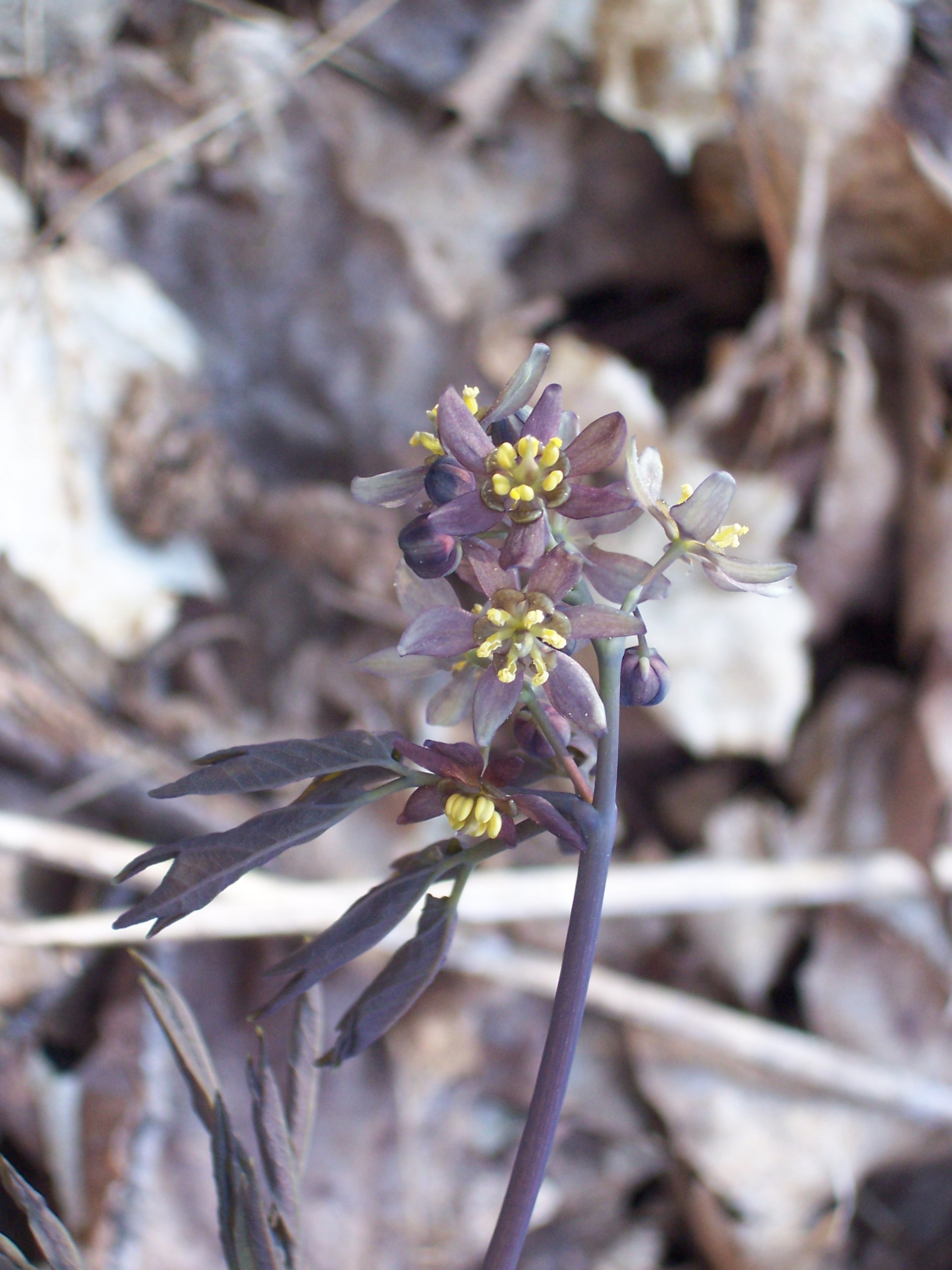This week, I’m featuring Cut-leaved Toothwort (Cardamine concatenata) as one of our local wildflowers that begins to bloom at this time.


“Toothwort” refers to the tooth-like projections on its underground stem (rhizome) that are actually plant stem scars from the previous seasons’ growth; segments resemble a string of beads.
The presence of this spring ephemeral wildflower indicates that its soil has never been plowed under or subjected to heavy construction activities within the woodland where it grows. However, when the non-native Garlic Mustard (Alliaria petiolata) invades a woodland, this is one of the spring wildflowers whose numbers rapidly decline.

Photo Credit: https://anps.org/2016/02/29/know-your-natives-cut-leaf-toothwort/
Identification Tips:
Cut-leaved Toothwort develops quickly and it is one of the earlier spring wildflowers of woodlands.
This herbaceous perennial plant is about 3-10″ tall, producing from its rootstock both basal leaves and fertile shoots with upper leaves. The basal leaves are separate from the fertile shoots; they help to store energy for next year’s fertile shoots. A fertile shoot consists of a single flowering stalk with a whorl of 3 leaves. Each leaf is up to 3″ long and across, but palmately cleft into 3-5 narrow lobes with dentate teeth along the margins. The basal leaves and the upper leaves have a similar appearance; both types of leaves are greyish green to medium green and largely hairless. The central stalk is greyish green to medium green, smooth or slightly hairy, and unbranched.

The flowering stalk terminates into a short cluster (raceme) of white flowers that becomes longer as it matures. The flowers open up and become more erect in the presence of sunshine on warm spring days. Each fragrant flower is about ½” across when fully open, consisting of 4 predominately white petals. The petals are lanceolate-oblong and sometimes tinted with pink or light purple. The slender stems with each raceme are at least as long as the flowers; they are light green to purplish green. The blooming lasts about 2 weeks, but a single flower usually lasts about 4 days.

Each flower is replaced by an elongated and somewhat flattened seedpod up to an inch long with a short beak (i.e., a silique); this seedpod is held more or less erect. The seedpods are initially green, turning to brown in late spring. The small, brown, flattened seeds are arranged in a single row of 10-14 seeds within each seedpod. The ripened seedpod splits open with a twist to eject its seeds, usually several weeks after forming.

Photo Credit: G. D. Bebeau, https://www.friendsofthewildflowergarden.org/pages/plants/cutleavedtoothwort.html

Photo Credit: https://www.prairiemoon.com/cardamine-concatenata-toothwort-prairie-moon-nursery.html
This plant typically grows in dappled sunlight before the trees leaf out. After the plant blooms and bears fruit, its foliage turns yellow and fades away by the end of spring.

becomes dormant at the end of its annual growing cycle.
Folklore:
Men of the Haudenosaunee would carry the whole plant on their person or the root in their mouths in the belief it would attract women.
Culinary and Medicinal Uses:
The Iroquois used this plant for food; they ate the roots raw or boiled. The root system (rhizomes) produces small fleshy tubers, which are edible with a radish-like flavor inspiring another common name of Pepper Root. The rhizomes can be washed, chopped and ground in vinegar to be used as a horseradish substitute.

Photo Credit: G. D. Bebeau, https://www.friendsofthewildflowergarden.org/pages/plants/cutleavedtoothwort.html
The Haudenosaunee used this plant as a gastrointestinal aid, appetite stimulant, cold medicine, and heart medicine. Also, a poultice of its crushed roots was applied to the head for headaches.
Wildlife Value:
The nectar of the flowers attracts both long-tongued and short-tongued bees, including honey bees, bumblebees, Mason bees (Osmia spp.), cuckoo bees (Nomada spp.), Halictid bees (Halictus spp., Lasioglossum spp.), and Andrenid bees (Andrena spp.). Andrena arabis only collects pollen from plants in the genus Cardamine and Arabis, which is another genus in the mustard family (Brassicaceae). Less often, the nectar of the flowers attracts early spring butterflies and Giant Bee Fly (Bombylius major). Short-tongued bees also collect pollen from the flowers.

Photo Credit: Mary Anne Borge, https://thenaturalwebdotorg.files.wordpress.com/2015/04/rockhopper_20150419_0042.jpg?w=584&h=617
The larvae of a few species of butterflies will feed upon these leaves, including Checkered White (Pontia protodice), Clouded Sulphur (Colias philodice), and Spring Azure butterfly (Celastrina ladon). Caterpillars of Mustard White butterflies (Pieris napi oleraceae) and West Virginia White butterflies (Pieris virginiensis) also feed on the foliage of Toothworts. The latter species is in decline, in part due to the spread of the highly invasive Garlic Mustard noted above. The caterpillars of the West Virginia White butterflies are able to digest only a few species of the mustard family, those with which the butterflies evolved. Unfortunately, the chemical composition of Garlic Mustard is similar enough to that of Cut-leaved Toothwort to lure female butterflies to lay their eggs on it. Sadly, the resulting caterpillars cannot survive on a diet of Garlic Mustard and so they perish.

Photo Credit: Photo by Vicki DeLoach licensed under CC BY-NC-ND 2.0
The White-footed Mouse (Peromyscus leucopus) will sometimes eat the seeds of this plant as well as its tubers.
Where Found Locally:
























